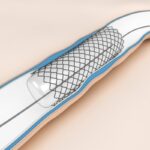Original title: Coronary artery bypass graft versus percutaneous coronary intervention with drug-eluting stent implantation for diabetic patients with unprotected left main coronary artery disease: D-DELTA registry. Reference: Meliga Emanuele, et al. EuroIntervention 2013; 9:803-808 Diabetes increases cardiovascular risk events because of their involvement in diffuse form of the vessels, thereby generating more events and changes in revascularization strategy…
Cilostazol reduces restenosis of DES in lesions larger than 40 mm.
Original title: Comparison of Dual Versus Triple Antiplatelet Therapy After Drug-Eluting Stent According to Stent Length (from the Pooled Analysis of DECLARE Trials). Reference: Seung-Whan Lee et al. Am J Cardiol 2013, article in press. Cilostazol, an inhibitor of phosphodiesterase III , associated with aspirin and clopidogrel showed decrease angiographic restenosis both in conventional stents as well as…
Paclitaxel eluting balloon . More effective in restenosis of BMS than DES
Original title: A multicenter randomized comparison of paclitaxel-coated balloon catheter with conventional balloon angioplasty in patients with bare-metal stent restenosis and drug-eluting stent restenosis. Referencia: Seiji Habara et al. Am Heart J 2013;166:527-533.e2. Paclitaxel – eluting balloons have recently emerged as an option for treating in-stent restenosis, both conventional stents ( BMS ) and with drugs (DES ).…
2nd generation drug-eluting stents intended for left main coronary artery
Original title: Zotarolimus- versus Everolimus-Eluting Stents for Unprotected Left Main Coronary Artery Disease. ISAR-LEFT MAIN 2 Study. Reference: Julinda Mehilli et al. J Am Coll Cardiol, article in press. Improvements in 2nd generation drug-eluting stents led to increased efficiency and safety , however there is little information on these new platforms to treat left main coronary artery .…
Double DES in bifurcations, double thrombosis risk
Original title: Late Thrombosis After Double Versus Single Drug-Eluting Stent in the Treatment of Coronary Bifurcations A Meta-analysis of Randomized and Observational Studies. Reference: Marco Zimarino et al. J Am Coll Cardiol Intv 2013. Article in press. In the era of drug-eluting stents, (DES), several randomized and observational studies have been conducted trying to find the best strategy…
A real challenge: Primary PCI on an Unprotected Left Main Coronary Culprit Lesion
Original title: A Systematic Review and Meta-Analysis on Primary Percutaneous Coronary Intervention on an Unprotected Left Main Coronary Artery Culprit Lesion in the setting of Acute Myocardial Infarction Reference: Marije M. Vis et al. J Am Coll Cardiol Intv 2013;6:317–24 Acute myocardial infarction with a significantly compromised unprotected left main coronary artery culprit lesion is relatively rare (4%…
Colchicine could reduce restenosis in diabetic patients treated with BMS
Original title: Colchicine Treatment for the Prevention of Bare-Metal Stent Restenosis in Diabetic Patients. Reference: Spyridon Deftereos et al. J Am Coll Cardiol 2013;61:1679–85. In stent restenosis is more frequent in diabetic patients, who therefore find DES particularly beneficial. However, there is a subset of these patients with contraindication to prolonged double antiaggregation, due to a programmed surgery…
Bioresorbable stents produce more occlusion of the small side branches
Original title: Incidence and Short-Term Clinical Outcomes of Small Side Branch Occlusion Alter Implantation of an Everolimus-Eluting Bioresorbable Vascular Scaffold Reference: Takashi Muramatsu et al. J Am Coll Cardiol Intv 2013;6:247–57. Small Side Branch Occlusion (SBO) during coronary angioplasty has been associated with periprocedural infarction. Among the factors that cause SBO are carina displacement, plaque displacement and artery…
Chronic Total Occlusion: increasingly better results and fewer complications.
Original title: Angiographic Success and Procedural Complications in Patients Undergoing Percutaneous Coronary Chronic Total Occlusion Interventions. A Weighted Meta-Analysis of 18,061 Patients From 65 Studies. Reference: Vishal G. Patel et al. J Am Coll Cardiol Intv 2013. Article in press. Chronic Total Occlusions (CTOs) are found in between 15% and 30% of patients undergoing coronary angioplasty. Successful CTOs…
Chronic Total Occlusions, challenging but very possible
Original title: Predictors of Reocclusion After Successful Drug-Eluting Stent–Supported Percutaneous Coronary Intervention of Chronic Total Occlusion. The Florence CTO PCI Registry. Reference: Renato Valenti et al. J Am Coll Cardiol 2013; article in press. Previous registry data have shown a reduction in mortality rates in patients with successful recanalization of a Chronic Total Occlusion (CTO) compared to patients…
Strategies for treating left coronary trunk restenosis.
Original title: Clinical and Procedural Predictors of Suboptimal Outcome After the Treatment of Drug-Eluting Stent Restenosis in the Unprotected Distal Left Main Stem The Milan and New-Tokyo (MITO) Registry. Reference: Circ Cardiovasc Interv. 2012;5: 491-498 We have very little data on the percutaneous treatment of restenosis of an unprotected LMCA. The aim of this study was to evaluate…










